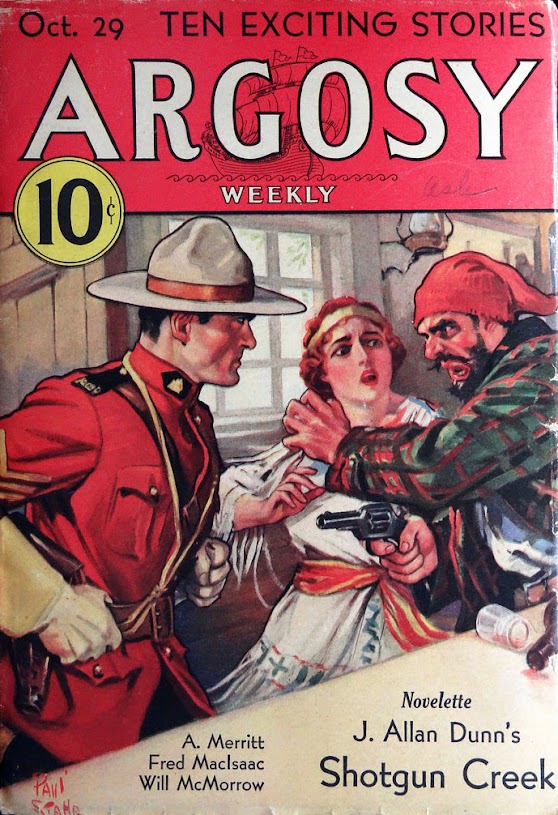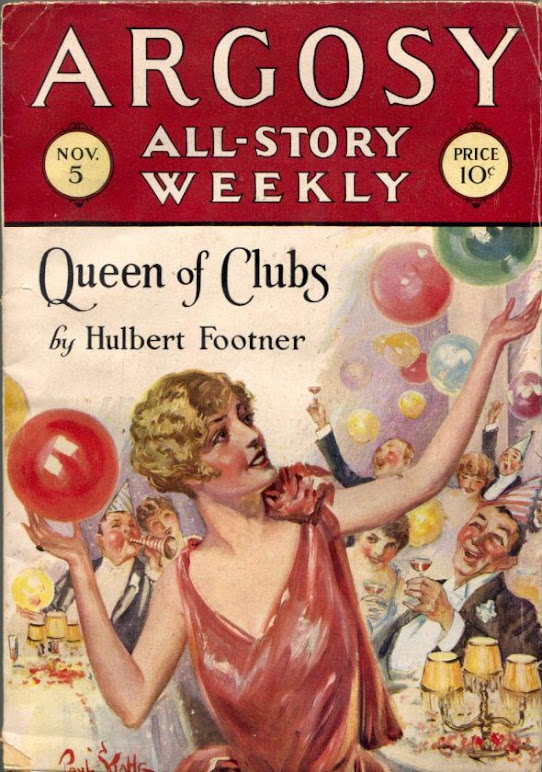Pulp magazines were inexpensive fiction magazines that were published from around 1896 to the 1950s. The term “pulp” derives from the cheap wood pulp on which the magazines were printed. In contrast, magazines printed on higher-quality paper were called "glossies" or "slicks".
The pulps gave rise to the term pulp fiction in reference to run-of-the-mill, low-quality literature. Pulps were the successors to the penny dreadfuls, dime novels, and short fiction magazines of the 1800s. Although many respected writers wrote for pulps, the magazines were best known for their lurid, exploitative, and sensational subject matter. Modern superhero comic books are sometimes considered descendants of "hero pulps"- pulp magazines often featured illustrated novel-length stories of heroic characters, such as Flash Gordon, The Shadow, Doc Savage, and the Phantom Detective.
At their peak of popularity in the 1920s and 1930s, the most successful pulps could sell up to one million copies per issue. The most successful pulp magazines were Argosy, Adventure, Blue Book, and Short Stories, collectively described by some pulp historians as "The Big Four.” Among the best known other titles of this period were Amazing Stories, Black Mask, and Dime Detective, among others.
1939 Robert de Graff launched Pocket Books. It was the first American mass-market-paperback line, and it transformed the industry. But paper book covers are almost as old as print. They date back to the sixteenth century, and paper-backing has been the ordinary mode of book production in France, for a long time. The first edition of James Joyce’s “Ulysses,” published in Paris in 1922, is a paperback. In the United States, paperback publishing was tried on a major scale at least twice during the nineteenth century: first, in the eighteen-forties, with an enterprise called the American Library of Useful Knowledge, and after the Civil War, when, unfettered by international copyright agreements, American publishers brought out cheap editions of popular European novels.
Many notable authors and books were first published as pulp fiction:
Tarzan of the Apes first appeared serialised in 1912-13 editions of All-Story magazine. Dashiell Hammet’s The Maltese Falcon was originally published in Black Mask magazine in 1930, and The Thin Man in 1934 in Redbook.
This is part 2 of a 4-part series on Pulp Fiction featuring the 1910s - 1920s.
Later larger series will feature Pulp Fiction of the 1930s, and Pulp Fiction of the 1940s - 1950s.
Paul Stahr (1883-1953)
In 1902 Paul Stahr began studying art at the National Academy of Design, where he won a bronze medal and graduated with honours. In 1905 he studied figure drawing with George Bridgman at the Art Students League. His career as a magazine illustrator began in 1913 when his drawings for interior stories were published in People's Home Journal. His works soon appeared regularly in Life, Collier's, Judge, Woman's Home Companion, and The Saturday Evening Post.
From 1924 until 1934 he worked extensively as a pulp cover artist for Argosy Magazine. He also illustrated covers for many books, including The Big Sleep by Raymond Chandler and The Saint by Leslie Charteris.
 |
| 1913 Judge magazine June 21 issue The Sum of Human Happiness |
 |
| 1914 Life magazine March issue Time to Cast Off |
 |
| 1923 The Elks October issue |
 |
| 1924 Columbia magazine February issue |
 |
| 1924 The Elks Magazine July issue |
 |
| 1924 The Elks September issue |
 |
| 1925 The Elks January issue |
 |
| 1925 The Elks June issue |
 |
| 1925 The Elks March issue |
 |
| 1925 The Elks October issue |
 |
| 1926 The Elks December issue |
 |
| 1927 Argosy All-Story-Weekly April 16 issue |
 |
| 1928 The War Chief by Edgar Rice Burroughs novel cover |
 |
| 1927 The Elks July issue |
 |
| 1928 The Elks February issue |
 |
| 1928 The Elks October issue |
 |
| 1929 The Elks January issue Happy New Year |
 |
| 1930 Argosy August 23 issue |
 |
| 1930 Argosy Magazine May 10 issue Voodoo'd |
 |
| 1945 Avon Murder Mystery Monthly The Ship of Ishtar |
 |
| 1931 Argosy June 20 issue The Grapevine Murders |
 |
| 1931 Argosy March 28 issue Mob |
 |
| 1931 Argosy May 16 issue original artwork |
 |
| 1931 Argosy May 16 issue Pirate of Wall Street |
 |
| 1932 Argosy January 30 issue Three Mounted Tramps |
 |
| 1932 Argosy Weekly November 5 issue Captain Dingle's Latest Sea Novel |
 |
| 1932 Argosy Weekly November 19 issue Sting of the Blue Scorpion |
 |
| 1932 Argosy Weekly November 26 issue The Jungle Trap |
 |
| 1932 Argosy Weekly October 8 issue Two Novelettes |
 |
| 1932 Argosy Weekly October 29 issue Shotgun Creek |
 |
| 1932 Argosy Weekly September 24 issue A Sultan of Java |
 |
| 1932 The Elks May issue |
 |
| 1933 Argosy Weekly April 22 issue Latest Legion Yarn |
 |
| 1933 Argosy Weekly February 25 issue The Master Magician |
 |
| 1933 Argosy Weekly January 21 issue Jimmie Cordie, Soldier of Fortune, in Manchuria! |
 |
| 1933 Argosy Weekly May 20 issue Solomon in the Catacombs |
 |
| 1933 The Elks Magazine January edition Happy New Year |
 |
| 1934 Argosy Weekly August 11 issue Zimwi Crater |
 |
| 1934 Argosy Weekly January 6 issue Camera! |
 |
| 1934 Argosy Weekly January 20 issue Sons of the Prophet |
 |
| 1934 Argosy Weekly November 3 issue War and the Camel Corps |
 |
| 1934 The Elks January issue Happy New Year |
 |
| 1934 The Elks May issue |
 |
| 1935 Argosy Weekly December 21 issue |
 |
| 1944 The Mystery of the Red Triangle by W.C. Tuttle Avon Books |
 |
| 1945 Double Indemnity by James M. Cain Avon Books |
 |
| 1945 A Homicide for Hannah by Dwight V. Babcock Avon Books No.68 |
 |
| 1945 Avon Murder Mystery Monthly No.28 Five Sinister Characters by Raymond Chandler |
 |
| 1945 Avon Murder Mystery Monthly The Face in the Abyss by A. Merritt |
 |
| 1946 Avon Murder Mystery Monthly The Metal Monster by A. Merritt |
 |
| Argosy All-Story Weekly Minions of the Law by Horace Howard Kerr |
 |
| Argosy All-Story Weekly Queen of Clubs by Hulbert Footner |
 |
| Argosy All-Story Weekly The Devil's Flower by John Wilstach |
 |
| Argosy Weekly - Ten Unusual Stories Lost on Venus by Edgar Rice Burroughs |
 |
| Argosy Weekly - March 31 Peter the Brazen vs. The Octopus of Hongkong |
 |
| Argosy Weekly - September 17 The Pirates of Venus |

No comments:
Post a Comment
Note: only a member of this blog may post a comment.